

| Investor Presentation February 2010 |

| This Management Presentation contains forward-looking statements. James Hardie may from time to time make forward-looking statements in its periodic reports filed with or furnished to the United States Securities and Exchange Commission on Forms 20-F and 6-K, in the annual reports to shareholders, in offering circulars, invitation memoranda and prospectuses, in media releases and other written materials and in oral statements made by the Company's officers, directors or employees to analysts, institutional investors, existing and potential lenders, representatives of the media and others. Statements that are not historical facts are forward-looking statements and such forward-looking statements are statements made pursuant to the Safe Harbor Provisions of the Private Securities Litigation Reform Act of 1995. Examples of forward-looking statements include: statements about the Company's future performance; projections of the Company's results of operations or financial condition; statements regarding the Company's plans, objectives or goals, including those relating to its strategies, initiatives, competition, acquisitions, dispositions and/or its products; expectations concerning the costs associated with the suspension or closure of operations at any of the Company's plants and future plans with respect to any such plants; expectations that the Company's credit facilities will be extended or renewed; expectations concerning dividend payments; statements concerning the Company's corporate and tax domiciles and potential changes to them, including potential tax charges; statements regarding tax liabilities and related audits, reviews and proceedings; statements as to the possible consequences of proceedings brought against the Company and certain of its former directors and officers by the ASIC; expectations about the timing and amount of contributions to the AICF, a special purpose fund for the compensation of proven Australian asbestos-related personal injury and death claims; expectations concerning indemnification obligations; and statements about product or environmental liabilities. Words such as "believe," "anticipate," "plan," "expect," "intend," "target," "estimate," "project," "predict," "forecast," "guideline," "aim," "will," "should," "continue" and similar expressions are intended to identify forward-looking statements but are not the exclusive means of identifying such statements. Readers are cautioned not to place undue reliance on these forward-looking statements and all such forward-looking statements are qualified in their entirety by reference to the following cautionary statements. Forward-looking statements are based on the Company's estimates and assumptions and because forward-looking statements address future results, events and conditions, they, by their very nature, involve inherent risks and uncertainties. Such known and unknown risks, uncertainties and other factors may cause the Company's actual results, performance or other achievements to differ materially from the anticipated results, performance or achievements expressed, projected or implied by these forward-looking statements. These factors, some of which are discussed under "Key Information - Risk Factors" beginning on page 6 of the Form 20-F filed with the US Securities and Exchange Commission on 25 June 2009, include, but are not limited to: all matters relating to or arising out of the prior manufacture of products that contained asbestos by current and former James Hardie subsidiaries; required contributions to the AICF, any shortfall in the AICF and the effect of currency exchange rate movements on the amount recorded in the Company's financial statements as an asbestos liability; compliance with and changes in tax laws and treatments; competition and product pricing in the markets in which the Company operates; the consequences of product failures or defects; exposure to environmental, asbestos or other legal proceedings; general economic and market conditions; the supply and cost of raw materials; the success of research and development efforts; reliance on a small number of customers; a customer's inability to pay; compliance with and changes in environmental and health and safety laws; risks of conducting business internationally; the Company's pending transformation to a Dutch "SE" company and proposal to transfer its corporate domicile from The Netherlands to Ireland to become an Irish "SE" company; compliance with and changes in laws and regulations; currency exchange risks; the concentration of the Company's customer base on large format retail customers, distributors and dealers; the effect of natural disasters; changes in the Company's key management personnel; inherent limitations on internal controls; use of accounting estimates; and all other risks identified in the Company's reports filed with Australian, Dutch and US securities agencies and exchanges (as appropriate). The Company cautions that the foregoing list of factors is not exhaustive and that other risks and uncertainties may cause actual results to differ materially from those in forward-looking statements. Forward-looking statements speak only as of the date they are made and are statements of the Company's current expectations concerning future results, events and conditions. 2 Disclaimer |

| 3 Operations, strategy and performance USA and Europe Fibre Cement Asia Pacific Fibre Cement Organisational focus Financial history Corporate issues Summary Agenda In this Management Presentation, James Hardie may present financial measures, sales volume terms, financial ratios, and Non-US GAAP financial measures included in the Definitions section of this document starting on page 50. The company presents financial measures that it believes are customarily used by its Australian investors. Specifically, these financial measures, which are equivalent to or derived from certain US GAAP measures as explained in the definitions, include "EBIT", "EBIT margin", "Operating profit" and "Net operating profit". The company may also present other terms for measuring its sales volumes ("million square feet or mmsf" and "thousand square feet or msf"); financial ratios ("Gearing ratio", "Net interest expense cover", "Net interest paid cover", "Net debt payback", "Net debt (cash)"); and Non-US GAAP financial measures ("EBIT excluding asbestos, ASIC expenses and asset impairments", "EBIT margin excluding asbestos, ASIC expenses and asset impairments", "Net operating profit excluding asbestos, ASIC expenses, asset impairments and tax adjustments", "Diluted earnings per share excluding asbestos, ASIC expenses, asset impairments and tax adjustments", "Operating profit before income taxes excluding asbestos and asset impairments", "Effective tax rate excluding asbestos, asset impairments and tax adjustments", "EBITDA" and "General corporate costs excluding domicile change related costs"). Unless otherwise stated, results and comparisons are of the 1st quarter and current fiscal year versus the 1st quarter of the prior fiscal year. |

| 4 Operations, strategy and performance USA and Europe Fibre Cement Asia Pacific Fibre Cement Organisational focus Financial history Corporate issues Summary Agenda |
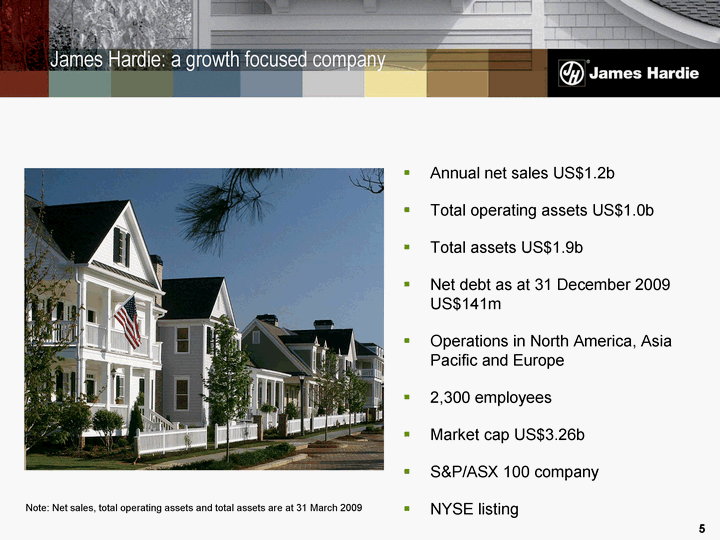
| 5 Annual net sales US$1.2b Total operating assets US$1.0b Total assets US$1.9b Net debt as at 31 December 2009 US$141m Operations in North America, Asia Pacific and Europe 2,300 employees Market cap US$3.26b S&P/ASX 100 company NYSE listing Note: Net sales, total operating assets and total assets are at 31 March 2009 James Hardie: a growth focused company |
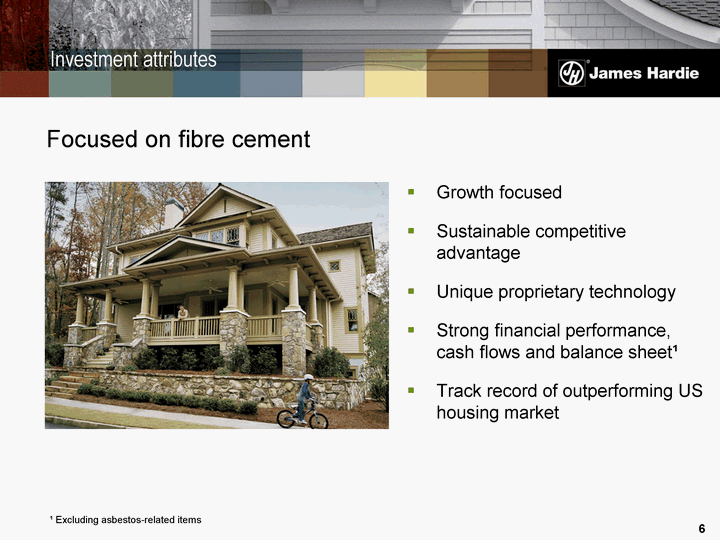
| 6 Growth focused Sustainable competitive advantage Unique proprietary technology Strong financial performance, cash flows and balance sheet1 Track record of outperforming US housing market Focused on fibre cement 1 Excluding asbestos-related items 1 Excluding asbestos-related items Investment attributes |
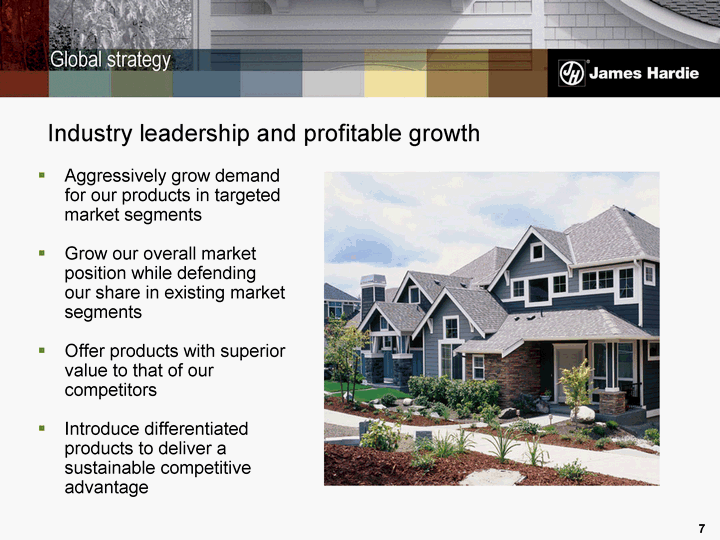
| 7 Aggressively grow demand for our products in targeted market segments Grow our overall market position while defending our share in existing market segments Offer products with superior value to that of our competitors Introduce differentiated products to deliver a sustainable competitive advantage Industry leadership and profitable growth Global strategy |
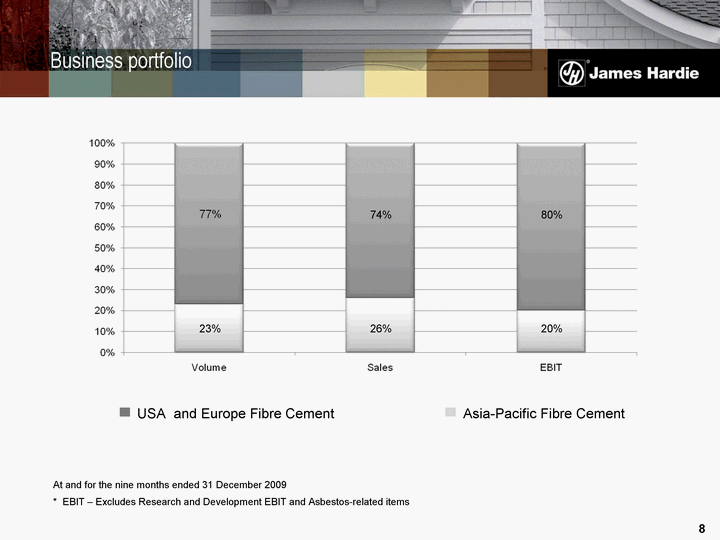
| 8 Business portfolio At and for the nine months ended 31 December 2009 * EBIT - Excludes Research and Development EBIT and Asbestos-related items USA and Europe Fibre Cement Asia-Pacific Fibre Cement 74% 80% 20% 26% 23% |
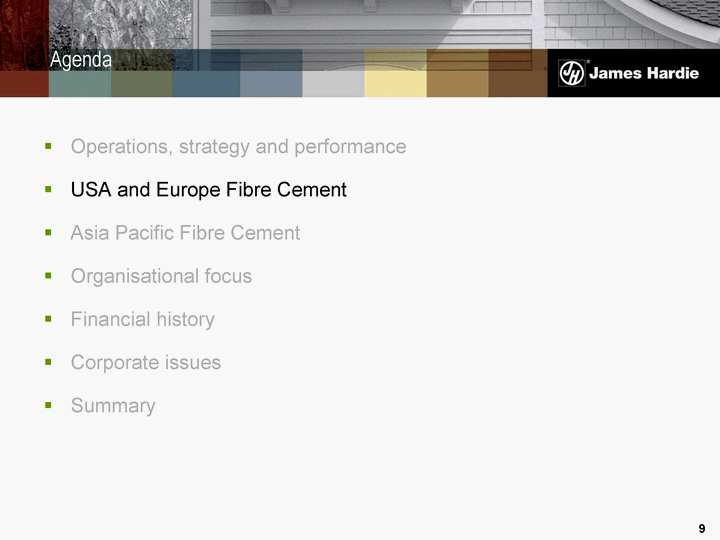
| 9 Operations, strategy and performance USA and Europe Fibre Cement Asia Pacific Fibre Cement Organisational focus Financial history Corporate issues Summary Agenda |
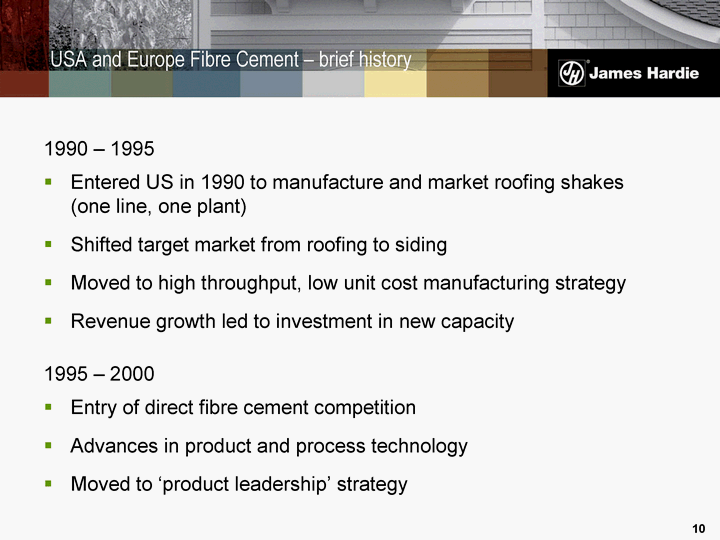
| 10 1990 - 1995 Entered US in 1990 to manufacture and market roofing shakes (one line, one plant) Shifted target market from roofing to siding Moved to high throughput, low unit cost manufacturing strategy Revenue growth led to investment in new capacity 1995 - 2000 Entry of direct fibre cement competition Advances in product and process technology Moved to 'product leadership' strategy USA and Europe Fibre Cement - brief history |
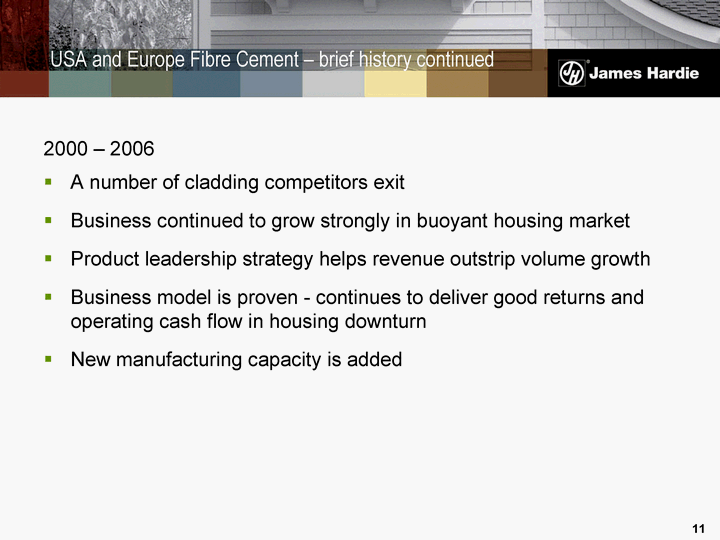
| 11 2000 - 2006 A number of cladding competitors exit Business continued to grow strongly in buoyant housing market Product leadership strategy helps revenue outstrip volume growth Business model is proven - continues to deliver good returns and operating cash flow in housing downturn New manufacturing capacity is added USA and Europe Fibre Cement - brief history continued |
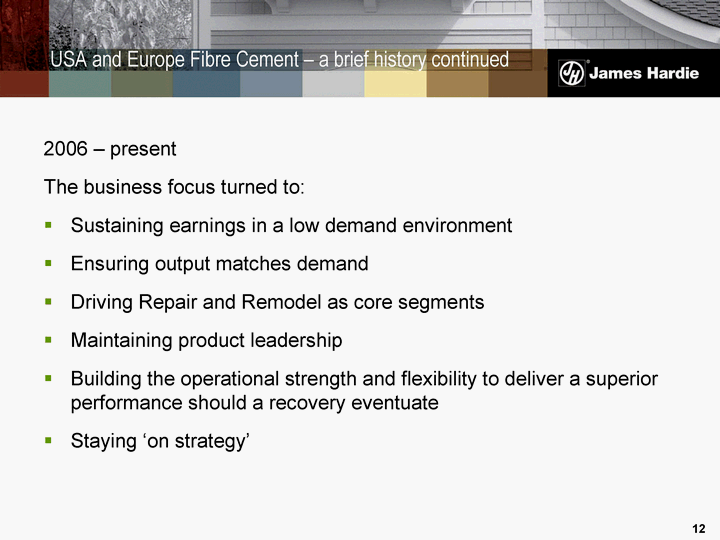
| 12 2006 - present The business focus turned to: Sustaining earnings in a low demand environment Ensuring output matches demand Driving Repair and Remodel as core segments Maintaining product leadership Building the operational strength and flexibility to deliver a superior performance should a recovery eventuate Staying 'on strategy' USA and Europe Fibre Cement - a brief history continued |
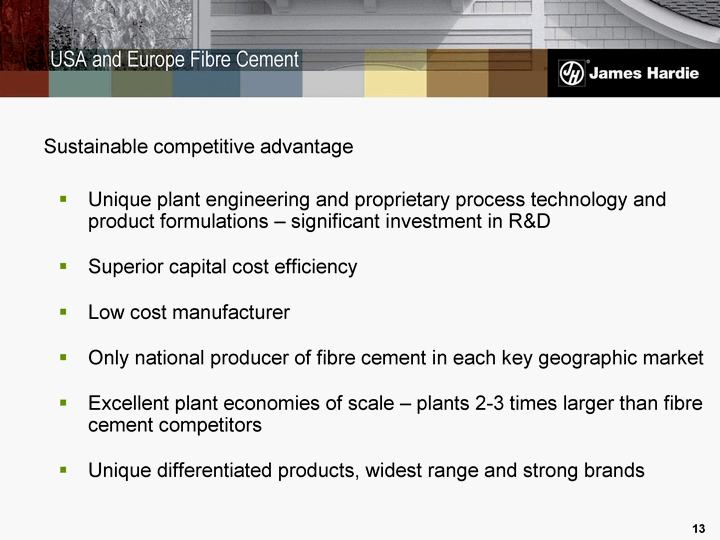
| 13 Sustainable competitive advantage Unique plant engineering and proprietary process technology and product formulations - significant investment in R&D Superior capital cost efficiency Low cost manufacturer Only national producer of fibre cement in each key geographic market Excellent plant economies of scale - plants 2-3 times larger than fibre cement competitors Unique differentiated products, widest range and strong brands USA and Europe Fibre Cement |
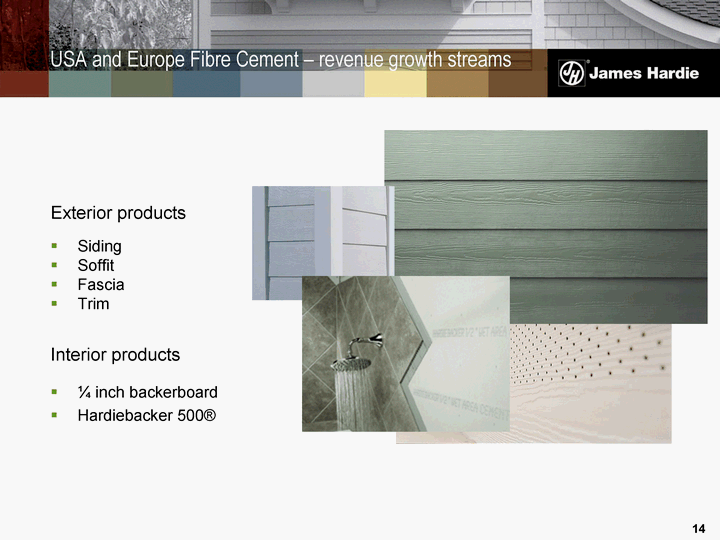
| 14 Exterior products Siding Soffit Fascia Trim Interior products 1/4 inch backerboard Hardiebacker 500(r) USA and Europe Fibre Cement - revenue growth streams |

| 15 USA and Europe Fibre Cement - sales mix New Construction vs. Repair and Remodel New Construction R&R Total Sales 35% 65% Exterior Products 39% 61% Interior Products 25% 75% Exterior vs. Interior Products Exteriors Interiors Volume 72% 28% Revenue 80% 20% All market and market share figures are management estimates and cannot be accurately measured |
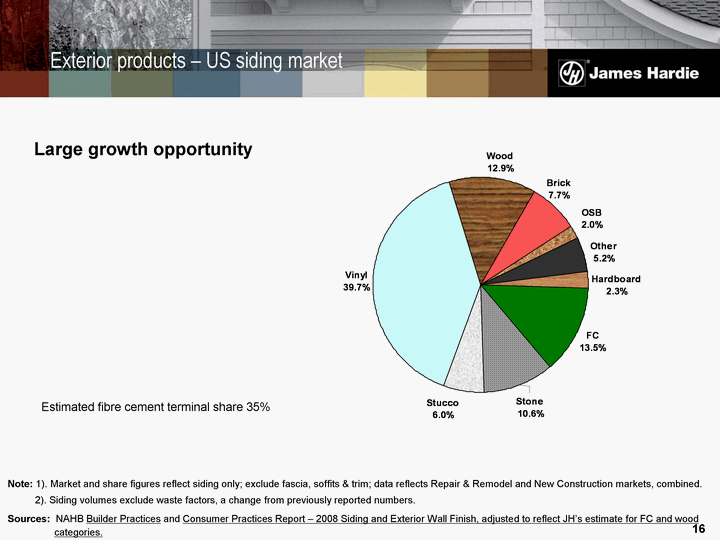
| 16 Exterior products - US siding market Large growth opportunity Estimated fibre cement terminal share 35% Note: 1). Market and share figures reflect siding only; exclude fascia, soffits & trim; data reflects Repair & Remodel and New Construction markets, combined. 2). Siding volumes exclude waste factors, a change from previously reported numbers. Sources: NAHB Builder Practices and Consumer Practices Report - 2008 Siding and Exterior Wall Finish, adjusted to reflect JH's estimate for FC and wood categories. |
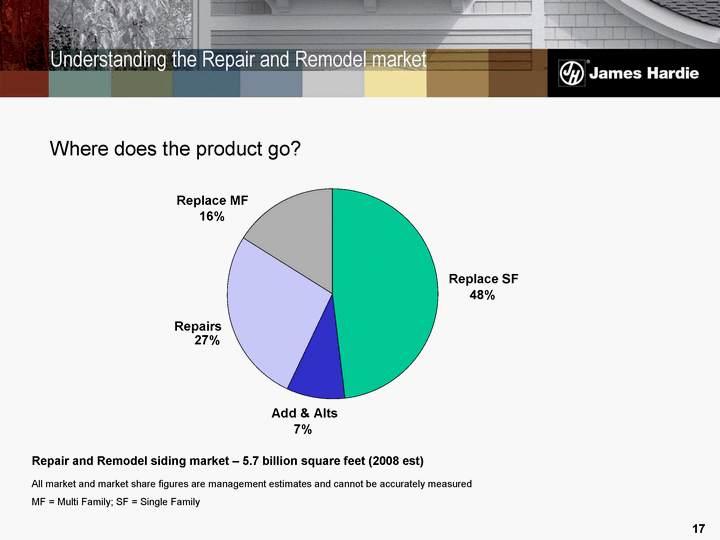
| 17 Understanding the Repair and Remodel market Repair and Remodel siding market - 5.7 billion square feet (2008 est) Replace SF 48% Add & Alts 7% Repairs 27% Replace MF 16% All market and market share figures are management estimates and cannot be accurately measured MF = Multi Family; SF = Single Family Where does the product go? |
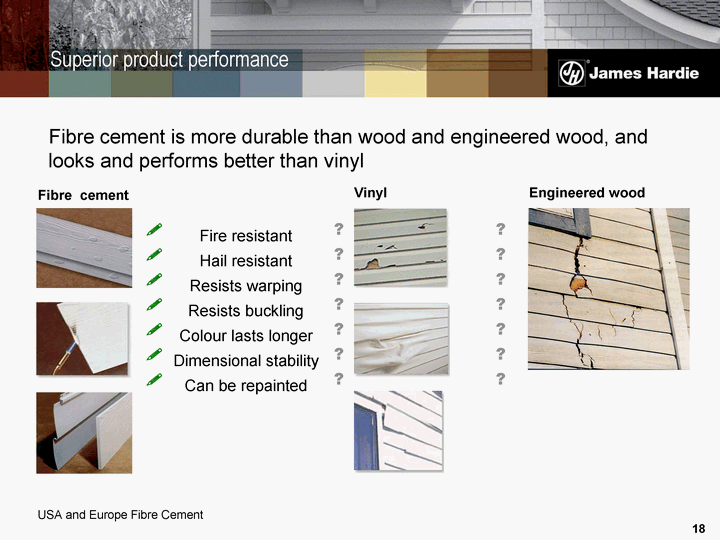
| 18 Fibre cement is more durable than wood and engineered wood, and looks and performs better than vinyl Vinyl Fire resistant Hail resistant Resists warping Resists buckling Colour lasts longer Dimensional stability Can be repainted ? ? ? ? ? ? ? ? ? ? ? ? ? ? Fibre cement USA and Europe Fibre Cement Engineered wood ? ? ? ? ? ? ? Superior product performance |
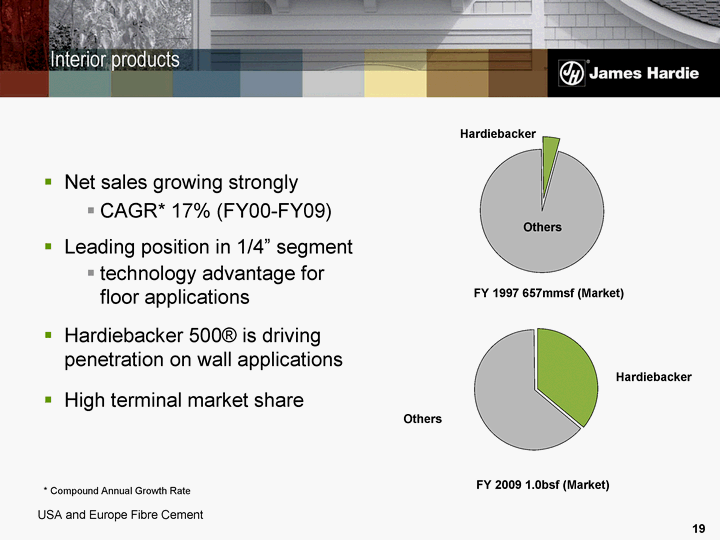
| 19 Interior products Net sales growing strongly CAGR* 17% (FY00-FY09) Leading position in 1/4" segment technology advantage for floor applications Hardiebacker 500(r) is driving penetration on wall applications High terminal market share * Compound Annual Growth Rate Hardiebacker FY 1997 657mmsf (Market) FY 2009 1.0bsf (Market) Others Hardiebacker Others USA and Europe Fibre Cement |
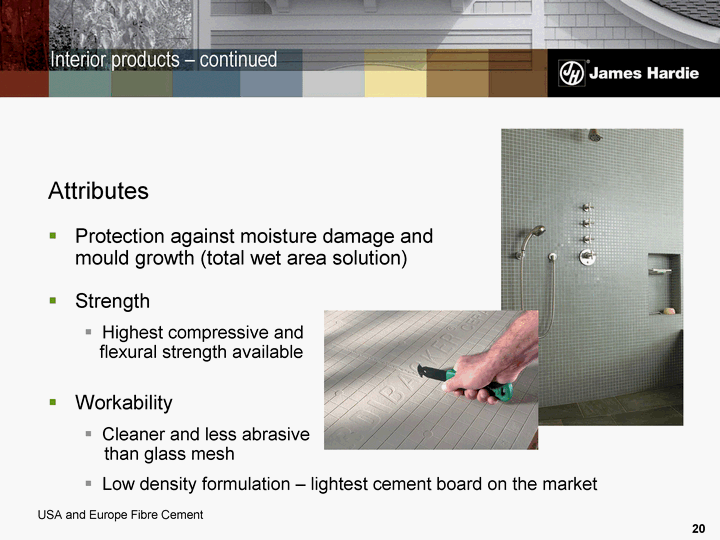
| 20 Attributes Protection against moisture damage and mould growth (total wet area solution) Strength Highest compressive and flexural strength available Workability Cleaner and less abrasive than glass mesh Low density formulation - lightest cement board on the market Interior products - continued USA and Europe Fibre Cement |
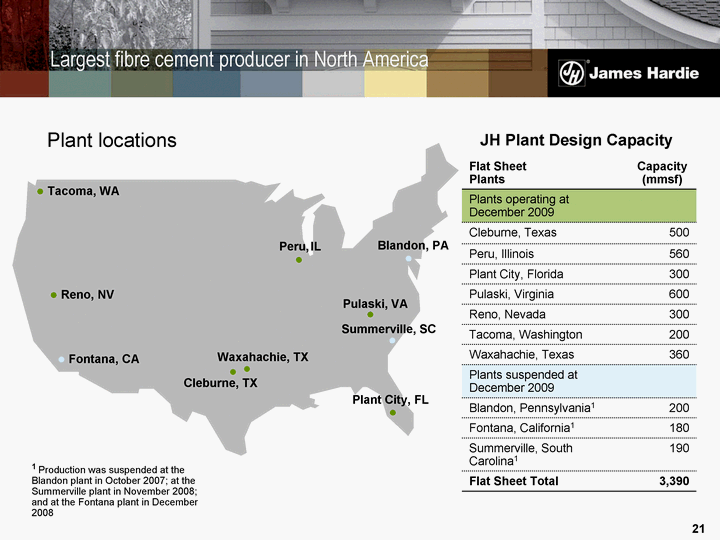
| 21 Flat Sheet Plants Capacity (mmsf) Plants operating at December 2009 Cleburne, Texas 500 Peru, Illinois 560 Plant City, Florida 300 Pulaski, Virginia 600 Reno, Nevada 300 Tacoma, Washington 200 Waxahachie, Texas 360 Plants suspended at December 2009 Blandon, Pennsylvania1 200 Fontana, California1 180 Summerville, South Carolina1 190 Flat Sheet Total 3,390 JH Plant Design Capacity Tacoma, WA Plant City, FL Waxahachie, TX Cleburne, TX Peru, IL Blandon, PA Summerville, SC Pulaski, VA Reno, NV Fontana, CA Plant locations 1 Production was suspended at the Blandon plant in October 2007; at the Summerville plant in November 2008; and at the Fontana plant in December 2008 Largest fibre cement producer in North America |
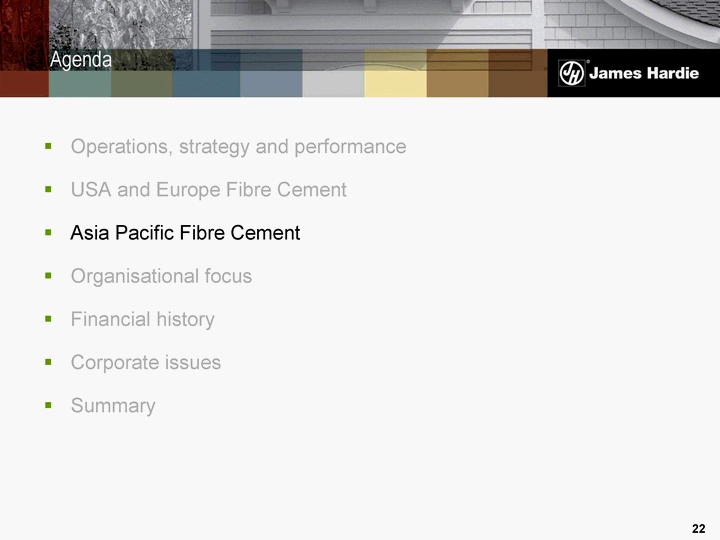
| 22 Operations, strategy and performance USA and Europe Fibre Cement Asia Pacific Fibre Cement Organisational focus Financial history Corporate issues Summary Agenda |
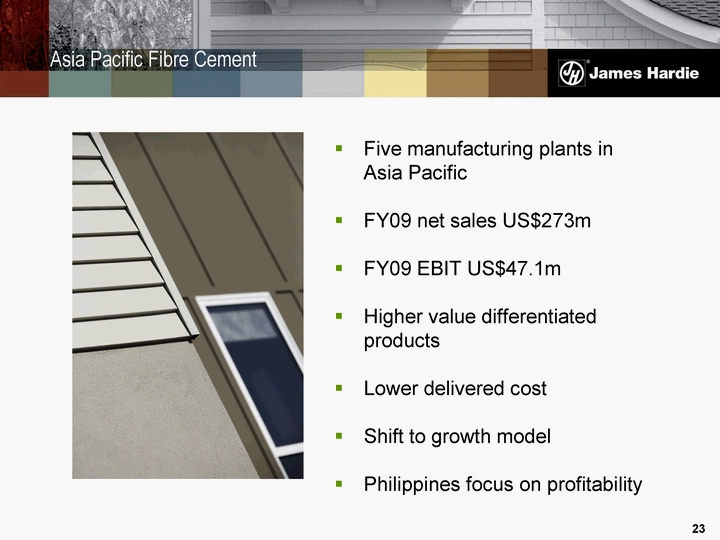
| 23 Five manufacturing plants in Asia Pacific FY09 net sales US$273m FY09 EBIT US$47.1m Higher value differentiated products Lower delivered cost Shift to growth model Philippines focus on profitability Asia Pacific Fibre Cement |

| 24 Operations, strategy and performance USA and Europe Fibre Cement Asia Pacific Fibre Cement Organisational focus Financial history Corporate issues Summary Agenda |
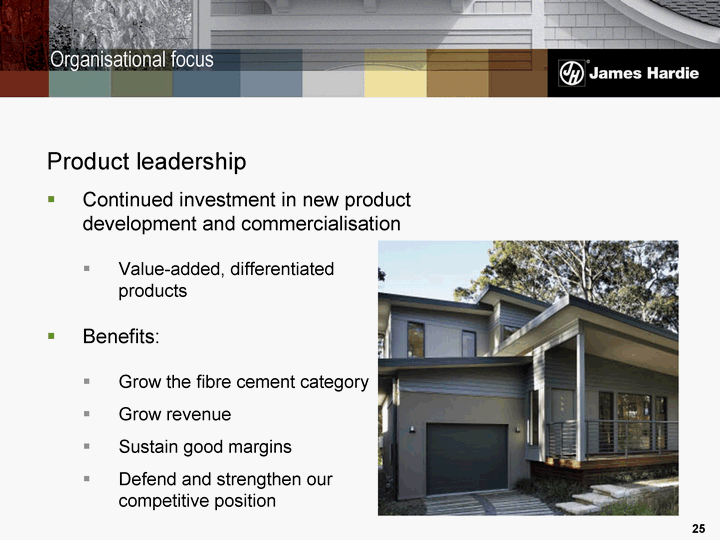
| 25 Product leadership Continued investment in new product development and commercialisation Value-added, differentiated products Benefits: Grow the fibre cement category Grow revenue Sustain good margins Defend and strengthen our competitive position Organisational focus |
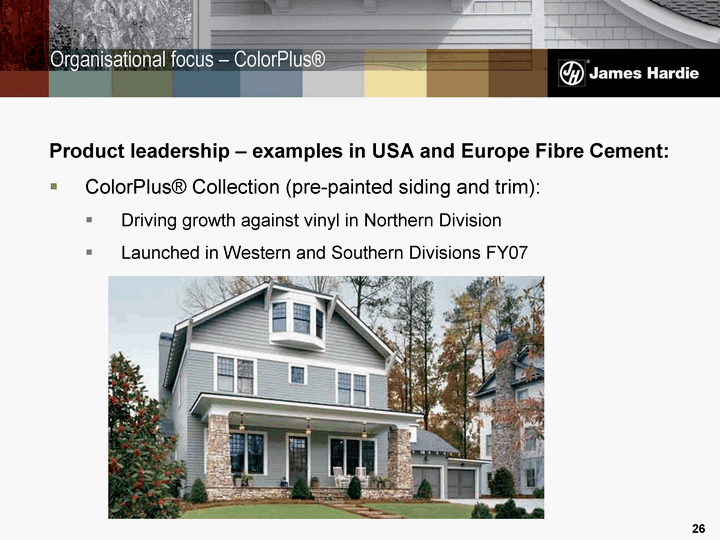
| 26 Product leadership - examples in USA and Europe Fibre Cement: ColorPlus(r) Collection (pre-painted siding and trim): Driving growth against vinyl in Northern Division Launched in Western and Southern Divisions FY07 Organisational focus - ColorPlus(r) |
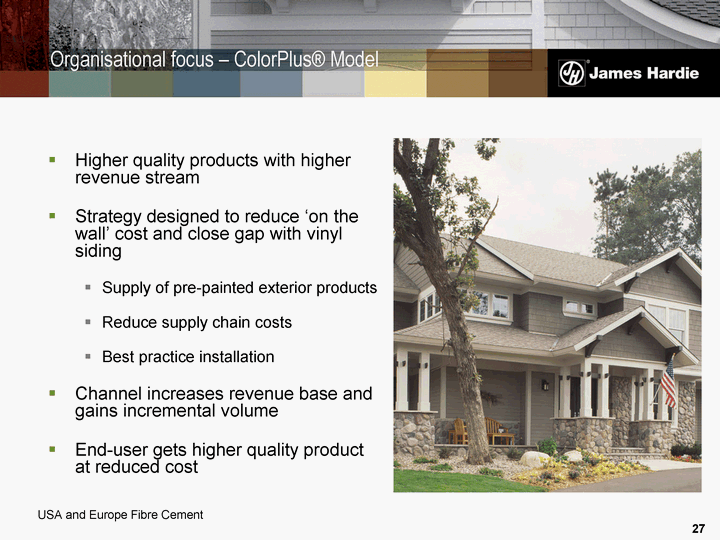
| 27 Higher quality products with higher revenue stream Strategy designed to reduce 'on the wall' cost and close gap with vinyl siding Supply of pre-painted exterior products Reduce supply chain costs Best practice installation Channel increases revenue base and gains incremental volume End-user gets higher quality product at reduced cost Organisational focus - ColorPlus(r) Model USA and Europe Fibre Cement |
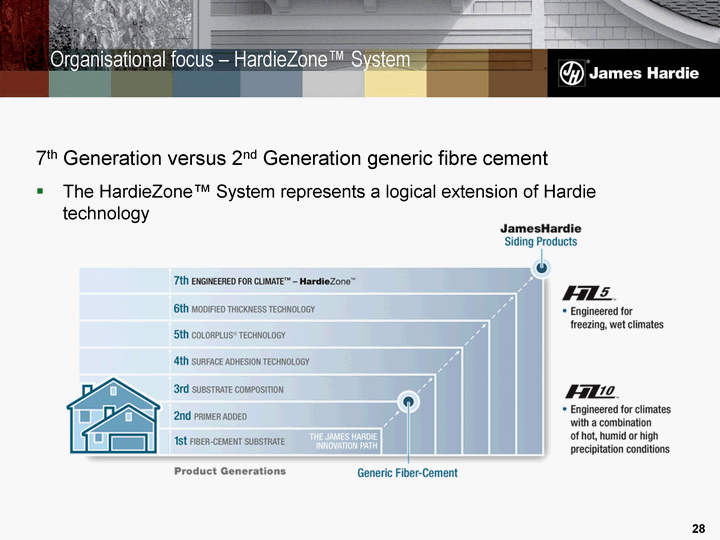
| 28 28 7th Generation versus 2nd Generation generic fibre cement The HardieZone(tm) System represents a logical extension of Hardie technology Organisational focus - HardieZone(tm) System |
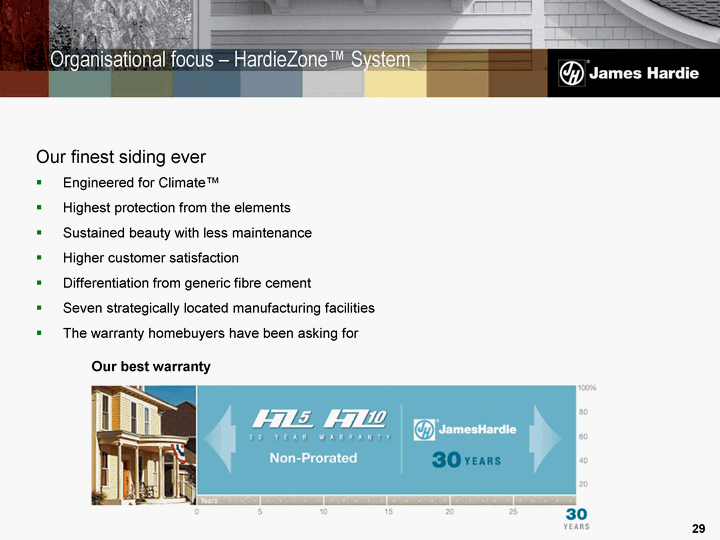
| 29 29 Our finest siding ever Engineered for Climate(tm) Highest protection from the elements Sustained beauty with less maintenance Higher customer satisfaction Differentiation from generic fibre cement Seven strategically located manufacturing facilities The warranty homebuyers have been asking for Our best warranty Organisational focus - HardieZone(tm) System |
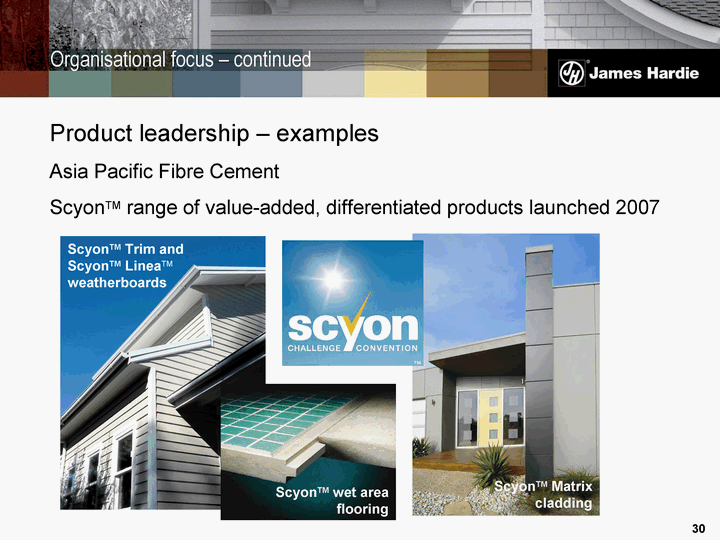
| 30 Product leadership - examples Asia Pacific Fibre Cement ScyonTM range of value-added, differentiated products launched 2007 ScyonTM wet area flooring ScyonTM Trim and ScyonTM LineaTM weatherboards ScyonTM Matrix cladding Organisational focus - continued |
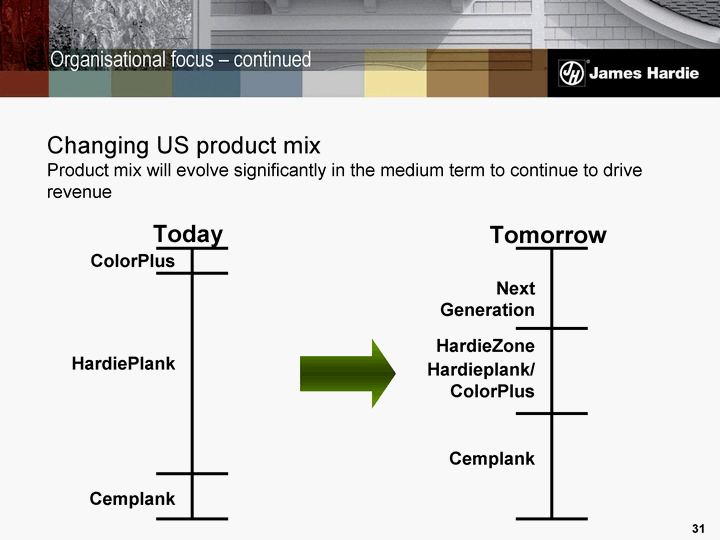
| 31 Today Tomorrow HardiePlank ColorPlus Cemplank Next Generation Cemplank HardieZone Hardieplank/ ColorPlus Changing US product mix Product mix will evolve significantly in the medium term to continue to drive revenue Organisational focus - continued |

| Total USA Housing Starts - NAHB NAHB forecast of 2010 Housing Starts has declined slightly since October's release. Source: NAHB Executive Level Forecasts - Total US Housing Starts (incl. SF, MF-low and MF-high) 32 |
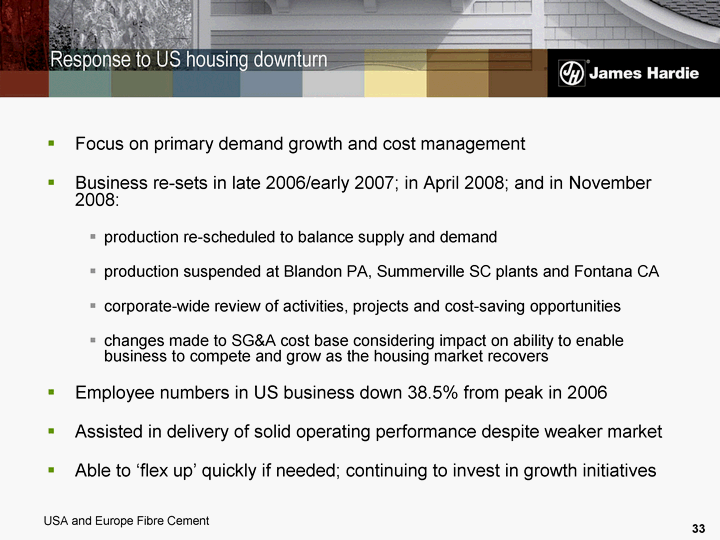
| 33 Focus on primary demand growth and cost management Business re-sets in late 2006/early 2007; in April 2008; and in November 2008: production re-scheduled to balance supply and demand production suspended at Blandon PA, Summerville SC plants and Fontana CA corporate-wide review of activities, projects and cost-saving opportunities changes made to SG&A cost base considering impact on ability to enable business to compete and grow as the housing market recovers Employee numbers in US business down 38.5% from peak in 2006 Assisted in delivery of solid operating performance despite weaker market Able to 'flex up' quickly if needed; continuing to invest in growth initiatives USA and Europe Fibre Cement Response to US housing downturn |
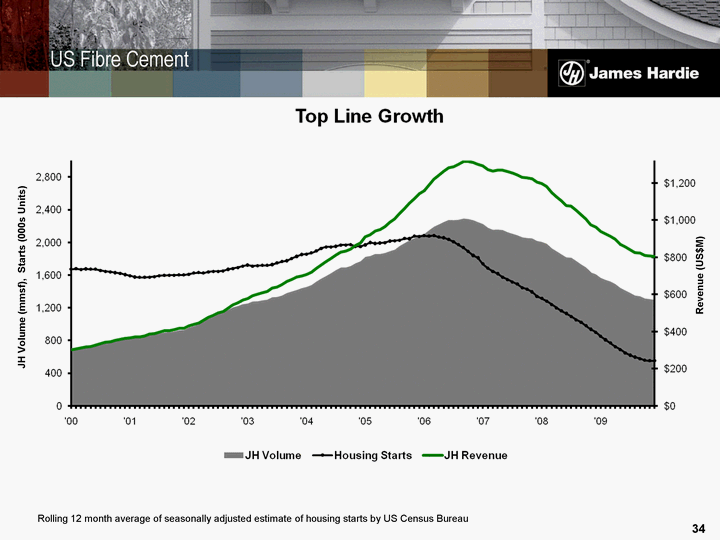
| Rolling 12 month average of seasonally adjusted estimate of housing starts by US Census Bureau JH Volume (mmsf), Starts (000s Units) Revenue (US$M) 34 US Fibre Cement |
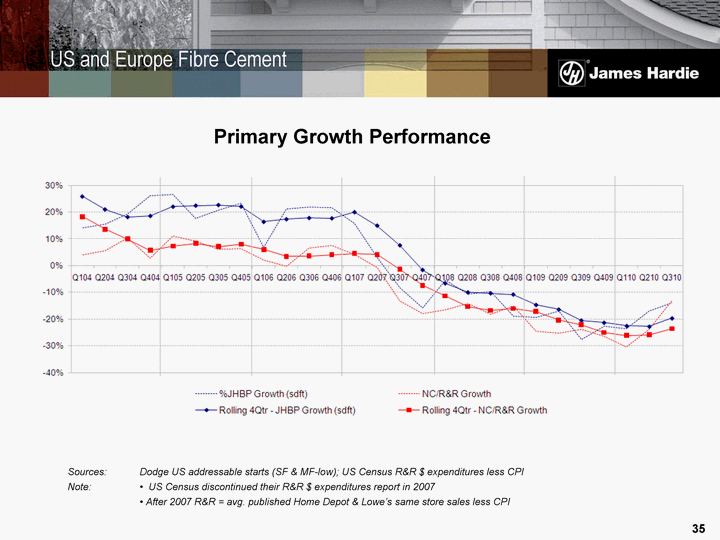
| Primary Growth Performance Sources: Dodge US addressable starts (SF & MF-low); US Census R&R $ expenditures less CPI Note: • US Census discontinued their R&R $ expenditures report in 2007 • After 2007 R&R = avg. published Home Depot & Lowe's same store sales less CPI 35 US and Europe Fibre Cement |
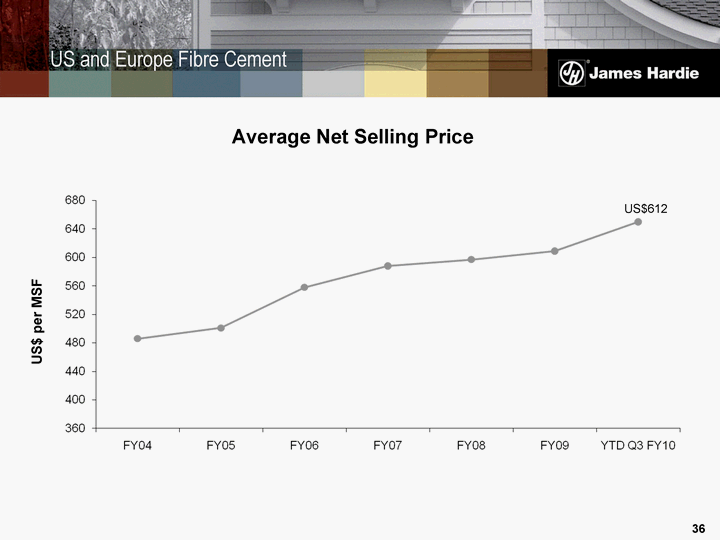
| Average Net Selling Price US$ per MSF US$612 36 US and Europe Fibre Cement |
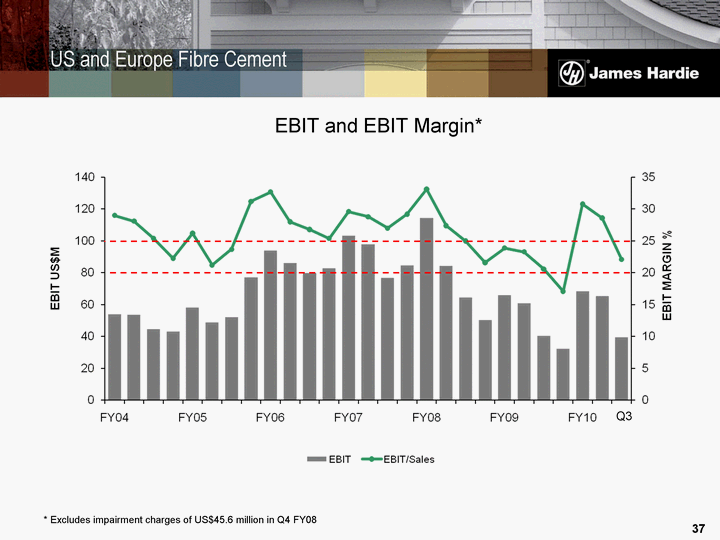
| * Excludes impairment charges of US$45.6 million in Q4 FY08 EBIT and EBIT Margin* Q3 US and Europe Fibre Cement 37 |
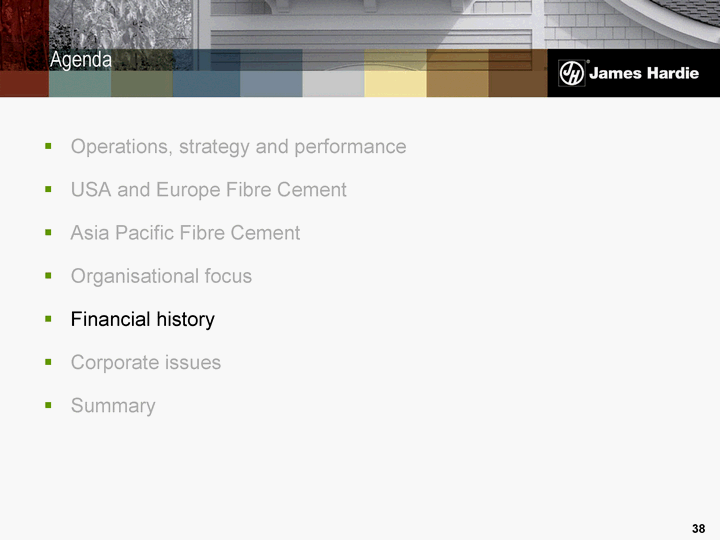
| Operations, strategy and performance USA and Europe Fibre Cement Asia Pacific Fibre Cement Organisational focus Financial history Corporate issues Summary Agenda 38 |
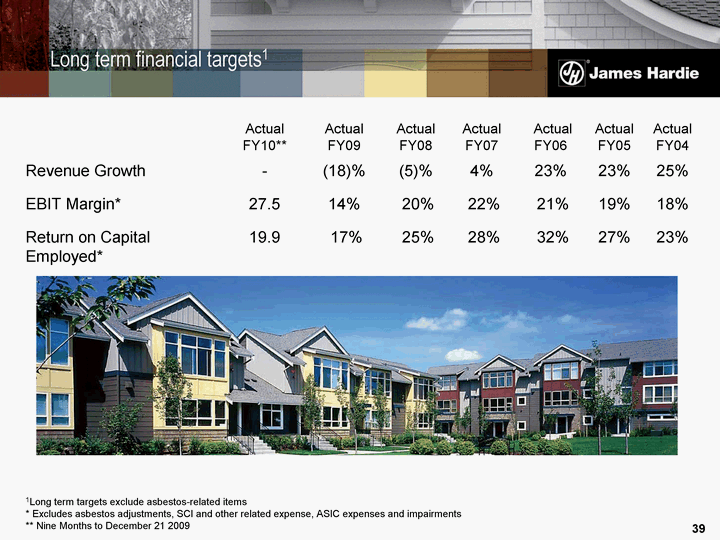
| Actual FY10** Actual FY09 Actual FY08 Actual FY07 Actual FY06 Actual FY05 Actual FY04 Revenue Growth - (18)% (5)% 4% 23% 23% 25% EBIT Margin* 27.5 14% 20% 22% 21% 19% 18% Return on Capital Employed* 19.9 17% 25% 28% 32% 27% 23% 1Long term targets exclude asbestos-related items * Excludes asbestos adjustments, SCI and other related expense, ASIC expenses and impairments ** Nine Months to December 21 2009 Long term financial targets1 39 |
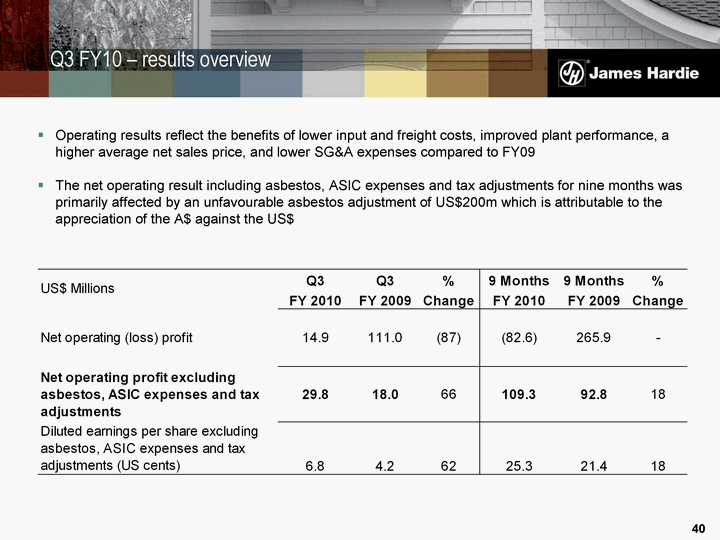
| Operating results reflect the benefits of lower input and freight costs, improved plant performance, a higher average net sales price, and lower SG&A expenses compared to FY09 The net operating result including asbestos, ASIC expenses and tax adjustments for nine months was primarily affected by an unfavourable asbestos adjustment of US$200m which is attributable to the appreciation of the A$ against the US$ Q3 FY10 - results overview 40 |
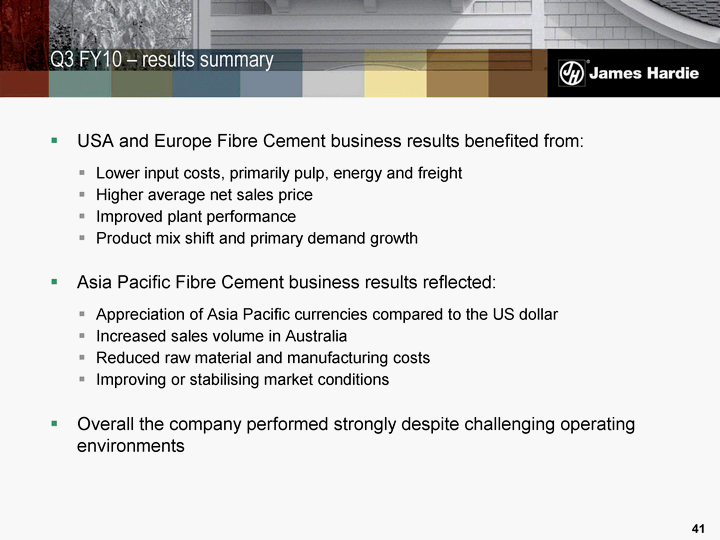
| USA and Europe Fibre Cement business results benefited from: Lower input costs, primarily pulp, energy and freight Higher average net sales price Improved plant performance Product mix shift and primary demand growth Asia Pacific Fibre Cement business results reflected: Appreciation of Asia Pacific currencies compared to the US dollar Increased sales volume in Australia Reduced raw material and manufacturing costs Improving or stabilising market conditions Overall the company performed strongly despite challenging operating environments Q3 FY10 - results summary 41 |
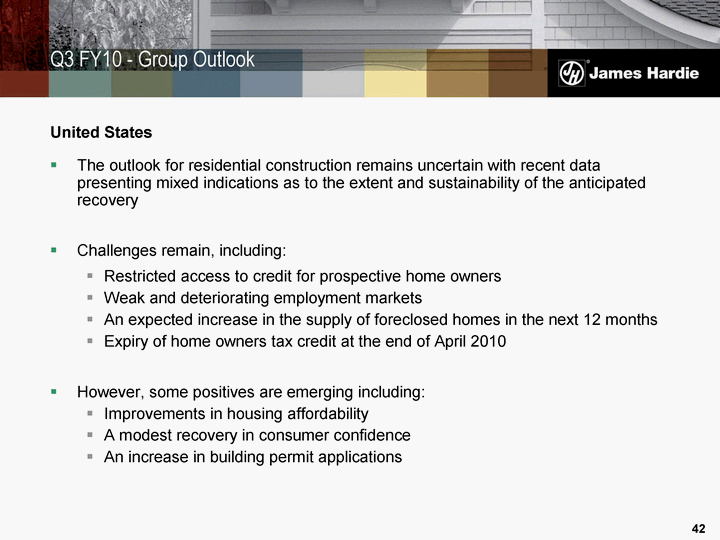
| United States The outlook for residential construction remains uncertain with recent data presenting mixed indications as to the extent and sustainability of the anticipated recovery Challenges remain, including: Restricted access to credit for prospective home owners Weak and deteriorating employment markets An expected increase in the supply of foreclosed homes in the next 12 months Expiry of home owners tax credit at the end of April 2010 However, some positives are emerging including: Improvements in housing affordability A modest recovery in consumer confidence An increase in building permit applications Q3 FY10 - Group Outlook 42 |
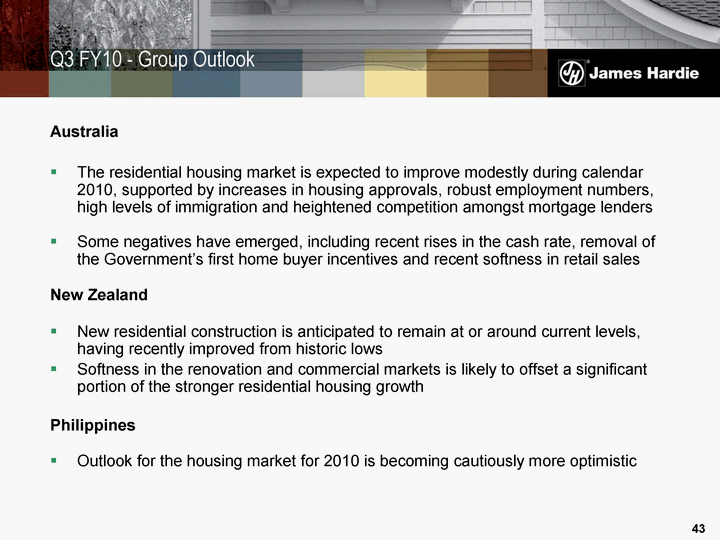
| Australia The residential housing market is expected to improve modestly during calendar 2010, supported by increases in housing approvals, robust employment numbers, high levels of immigration and heightened competition amongst mortgage lenders Some negatives have emerged, including recent rises in the cash rate, removal of the Government's first home buyer incentives and recent softness in retail sales New Zealand New residential construction is anticipated to remain at or around current levels, having recently improved from historic lows Softness in the renovation and commercial markets is likely to offset a significant portion of the stronger residential housing growth Philippines Outlook for the housing market for 2010 is becoming cautiously more optimistic Q3 FY10 - Group Outlook 43 |
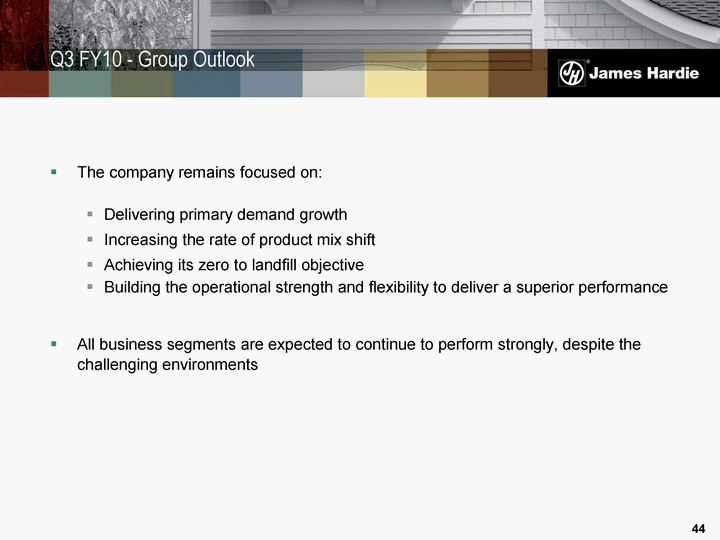
| The company remains focused on: Delivering primary demand growth Increasing the rate of product mix shift Achieving its zero to landfill objective Building the operational strength and flexibility to deliver a superior performance All business segments are expected to continue to perform strongly, despite the challenging environments Q3 FY10 - Group Outlook 44 |
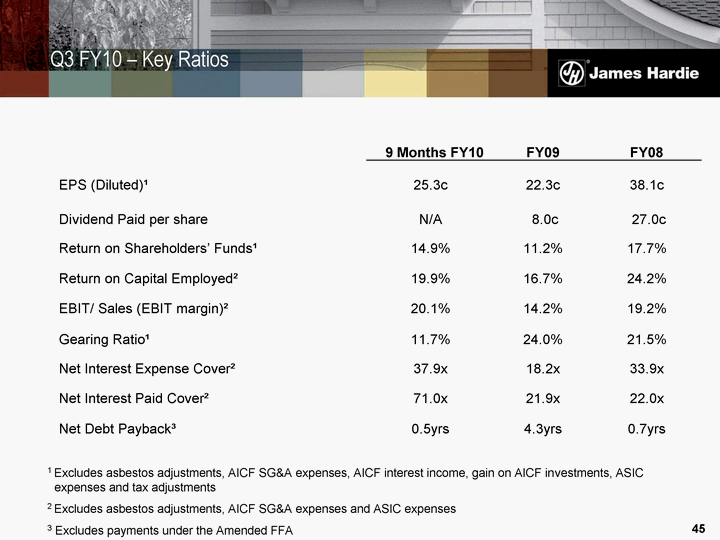
| 1 Excludes asbestos adjustments, AICF SG&A expenses, AICF interest income, gain on AICF investments, ASIC expenses and tax adjustments 2 Excludes asbestos adjustments, AICF SG&A expenses and ASIC expenses 3 Excludes payments under the Amended FFA 9 Months FY10 FY09 FY08 EPS (Diluted)1 25.3c 22.3c 38.1c Dividend Paid per share N/A 8.0c 27.0c Return on Shareholders' Funds1 14.9% 11.2% 17.7% Return on Capital Employed2 19.9% 16.7% 24.2% EBIT/ Sales (EBIT margin)2 20.1% 14.2% 19.2% Gearing Ratio1 11.7% 24.0% 21.5% Net Interest Expense Cover2 37.9x 18.2x 33.9x Net Interest Paid Cover2 71.0x 21.9x 22.0x Net Debt Payback3 0.5yrs 4.3yrs 0.7yrs Q3 FY10 - Key Ratios 45 |

| Operations, strategy and performance USA and Europe Fibre Cement Asia Pacific Fibre Cement Organisational focus Financial history Corporate issues Summary Agenda 46 |
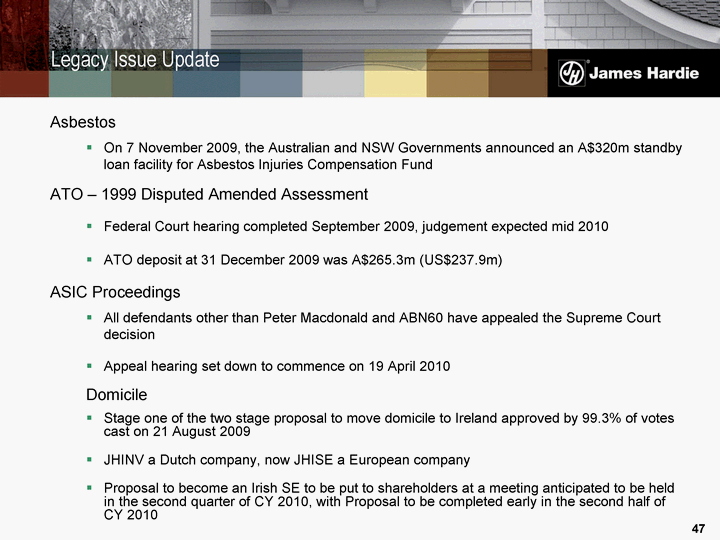
| Asbestos On 7 November 2009, the Australian and NSW Governments announced an A$320m standby loan facility for Asbestos Injuries Compensation Fund ATO - 1999 Disputed Amended Assessment Federal Court hearing completed September 2009, judgement expected mid 2010 ATO deposit at 31 December 2009 was A$265.3m (US$237.9m) ASIC Proceedings All defendants other than Peter Macdonald and ABN60 have appealed the Supreme Court decision Appeal hearing set down to commence on 19 April 2010 Domicile Stage one of the two stage proposal to move domicile to Ireland approved by 99.3% of votes cast on 21 August 2009 JHINV a Dutch company, now JHISE a European company Proposal to become an Irish SE to be put to shareholders at a meeting anticipated to be held in the second quarter of CY 2010, with Proposal to be completed early in the second half of CY 2010 Legacy Issue Update 47 |
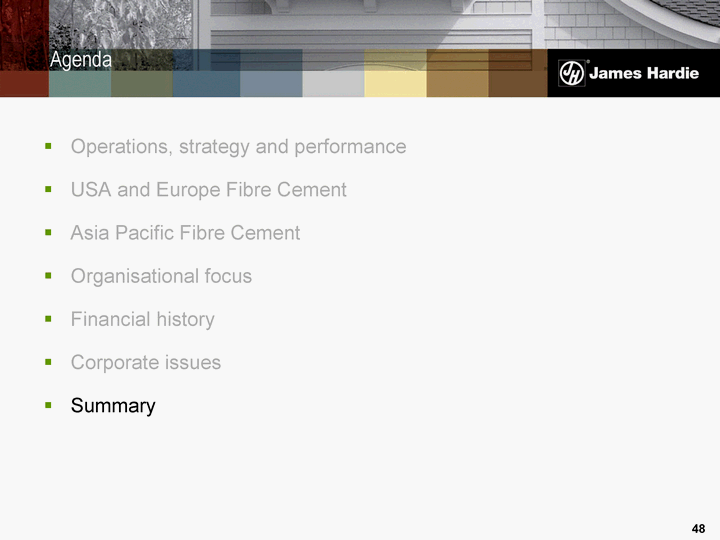
| Operations, strategy and performance USA and Europe Fibre Cement Asia Pacific Fibre Cement Organisational focus Financial history Corporate issues Summary Agenda 48 |
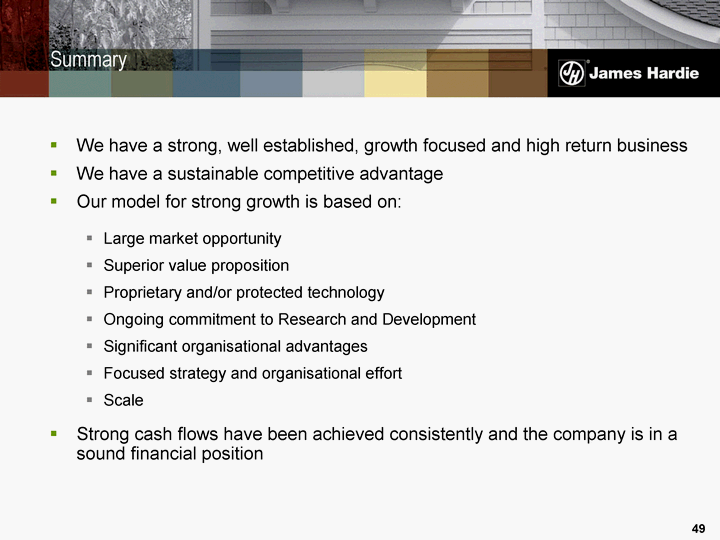
| We have a strong, well established, growth focused and high return business We have a sustainable competitive advantage Our model for strong growth is based on: Large market opportunity Superior value proposition Proprietary and/or protected technology Ongoing commitment to Research and Development Significant organisational advantages Focused strategy and organisational effort Scale Strong cash flows have been achieved consistently and the company is in a sound financial position Summary 49 |
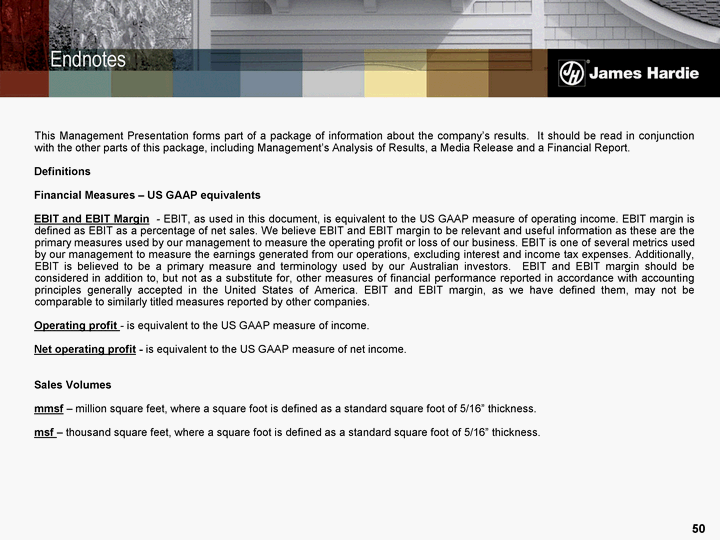
| This Management Presentation forms part of a package of information about the company's results. It should be read in conjunction with the other parts of this package, including Management's Analysis of Results, a Media Release and a Financial Report. Definitions Financial Measures - US GAAP equivalents EBIT and EBIT Margin - EBIT, as used in this document, is equivalent to the US GAAP measure of operating income. EBIT margin is defined as EBIT as a percentage of net sales. We believe EBIT and EBIT margin to be relevant and useful information as these are the primary measures used by our management to measure the operating profit or loss of our business. EBIT is one of several metrics used by our management to measure the earnings generated from our operations, excluding interest and income tax expenses. Additionally, EBIT is believed to be a primary measure and terminology used by our Australian investors. EBIT and EBIT margin should be considered in addition to, but not as a substitute for, other measures of financial performance reported in accordance with accounting principles generally accepted in the United States of America. EBIT and EBIT margin, as we have defined them, may not be comparable to similarly titled measures reported by other companies. Operating profit - is equivalent to the US GAAP measure of income. Net operating profit - is equivalent to the US GAAP measure of net income. Sales Volumes mmsf - million square feet, where a square foot is defined as a standard square foot of 5/16" thickness. msf - thousand square feet, where a square foot is defined as a standard square foot of 5/16" thickness. Endnotes 50 |
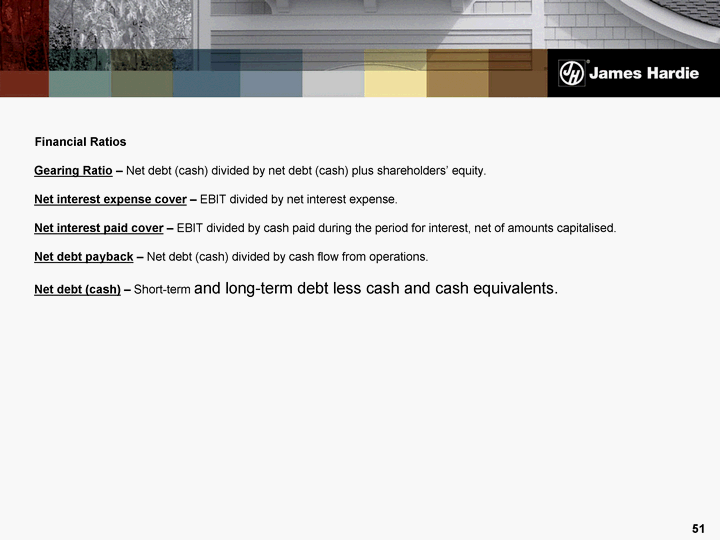
| Financial Ratios Gearing Ratio - Net debt (cash) divided by net debt (cash) plus shareholders' equity. Net interest expense cover - EBIT divided by net interest expense. Net interest paid cover - EBIT divided by cash paid during the period for interest, net of amounts capitalised. Net debt payback - Net debt (cash) divided by cash flow from operations. Net debt (cash) - Short-term and long-term debt less cash and cash equivalents. 51 |
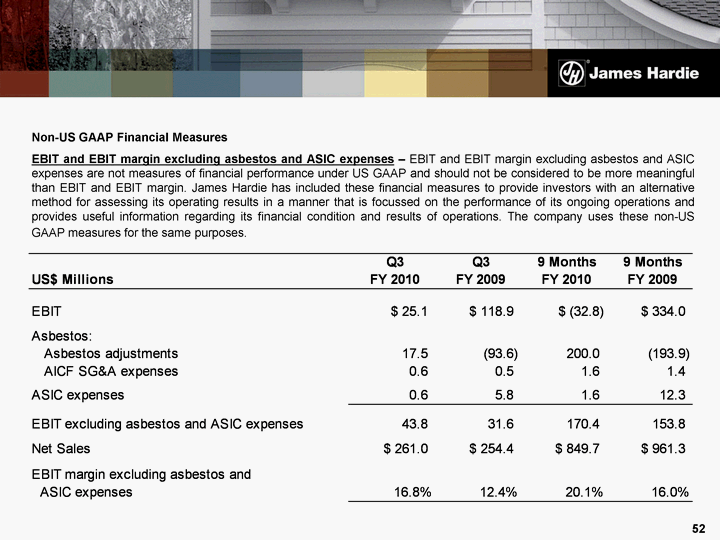
| Non-US GAAP Financial Measures EBIT and EBIT margin excluding asbestos and ASIC expenses - EBIT and EBIT margin excluding asbestos and ASIC expenses are not measures of financial performance under US GAAP and should not be considered to be more meaningful than EBIT and EBIT margin. James Hardie has included these financial measures to provide investors with an alternative method for assessing its operating results in a manner that is focussed on the performance of its ongoing operations and provides useful information regarding its financial condition and results of operations. The company uses these non-US GAAP measures for the same purposes. 52 |
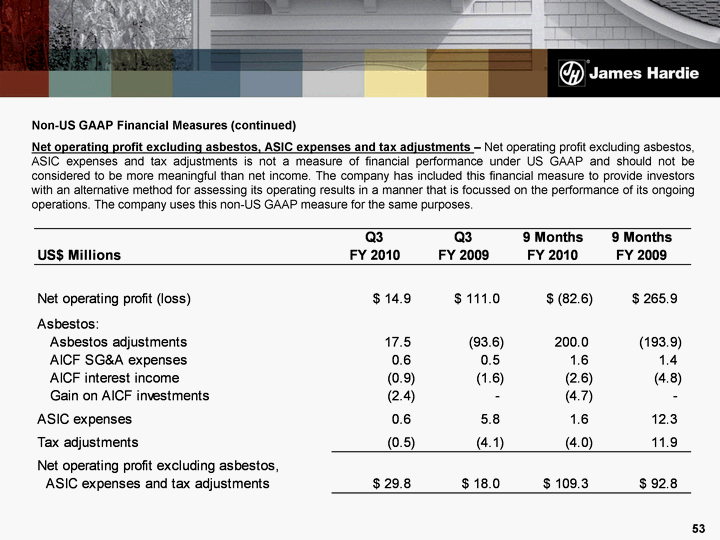
| Non-US GAAP Financial Measures (continued) Net operating profit excluding asbestos, ASIC expenses and tax adjustments - Net operating profit excluding asbestos, ASIC expenses and tax adjustments is not a measure of financial performance under US GAAP and should not be considered to be more meaningful than net income. The company has included this financial measure to provide investors with an alternative method for assessing its operating results in a manner that is focussed on the performance of its ongoing operations. The company uses this non-US GAAP measure for the same purposes. 53 |
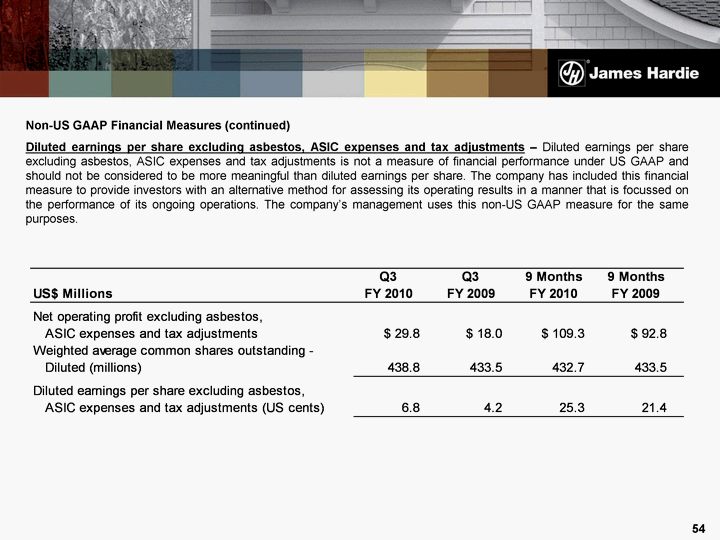
| Non-US GAAP Financial Measures (continued) Diluted earnings per share excluding asbestos, ASIC expenses and tax adjustments - Diluted earnings per share excluding asbestos, ASIC expenses and tax adjustments is not a measure of financial performance under US GAAP and should not be considered to be more meaningful than diluted earnings per share. The company has included this financial measure to provide investors with an alternative method for assessing its operating results in a manner that is focussed on the performance of its ongoing operations. The company's management uses this non-US GAAP measure for the same purposes. 54 |
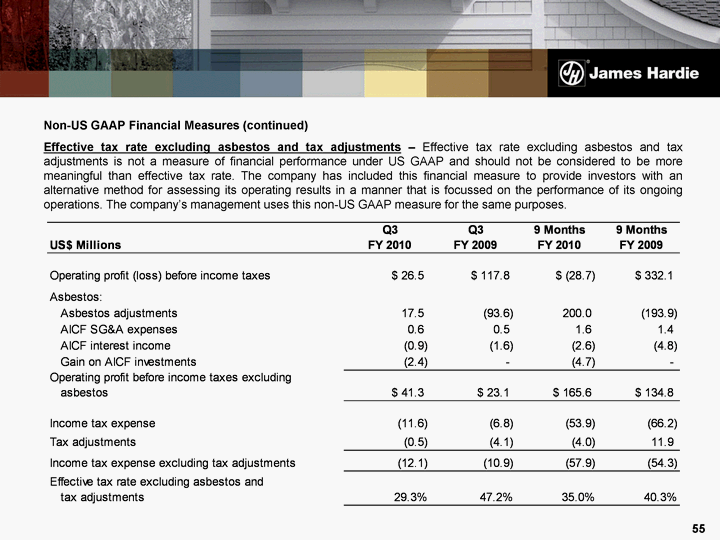
| Non-US GAAP Financial Measures (continued) Effective tax rate excluding asbestos and tax adjustments - Effective tax rate excluding asbestos and tax adjustments is not a measure of financial performance under US GAAP and should not be considered to be more meaningful than effective tax rate. The company has included this financial measure to provide investors with an alternative method for assessing its operating results in a manner that is focussed on the performance of its ongoing operations. The company's management uses this non-US GAAP measure for the same purposes. 55 |
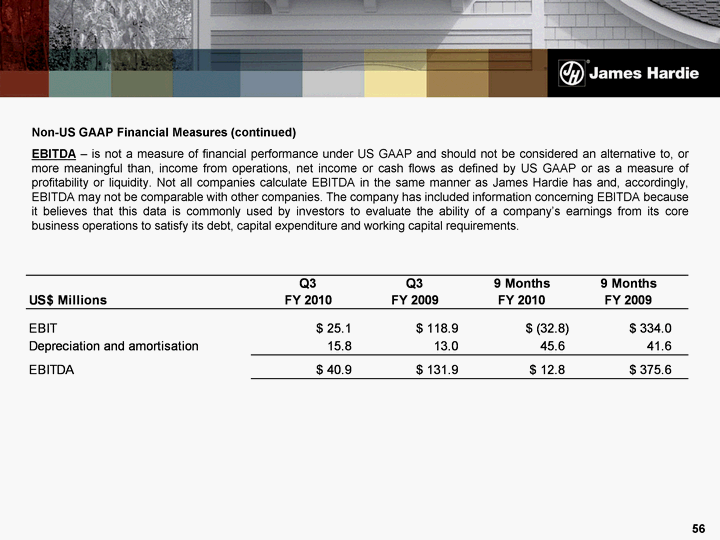
| Non-US GAAP Financial Measures (continued) EBITDA - is not a measure of financial performance under US GAAP and should not be considered an alternative to, or more meaningful than, income from operations, net income or cash flows as defined by US GAAP or as a measure of profitability or liquidity. Not all companies calculate EBITDA in the same manner as James Hardie has and, accordingly, EBITDA may not be comparable with other companies. The company has included information concerning EBITDA because it believes that this data is commonly used by investors to evaluate the ability of a company's earnings from its core business operations to satisfy its debt, capital expenditure and working capital requirements. 56 |
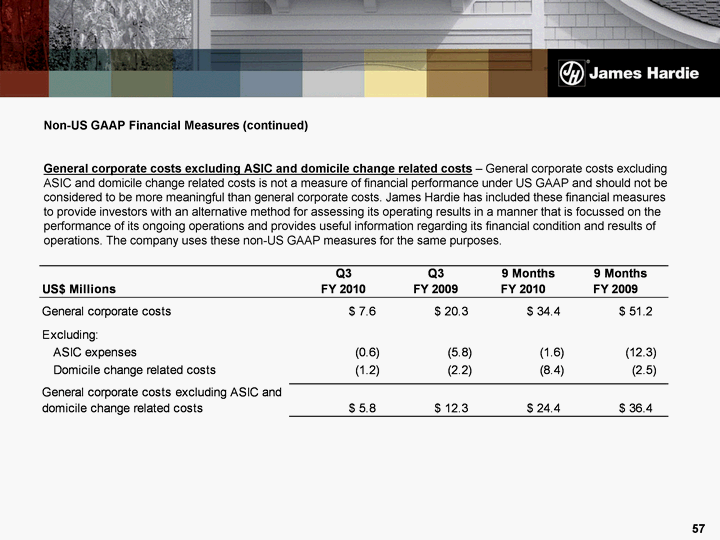
| Non-US GAAP Financial Measures (continued) General corporate costs excluding ASIC and domicile change related costs - General corporate costs excluding ASIC and domicile change related costs is not a measure of financial performance under US GAAP and should not be considered to be more meaningful than general corporate costs. James Hardie has included these financial measures to provide investors with an alternative method for assessing its operating results in a manner that is focussed on the performance of its ongoing operations and provides useful information regarding its financial condition and results of operations. The company uses these non-US GAAP measures for the same purposes. 57 |